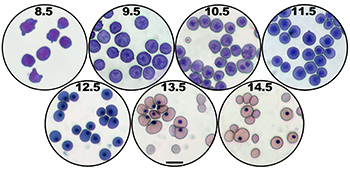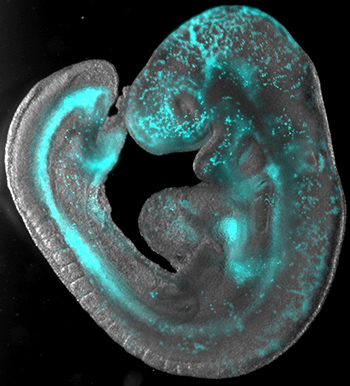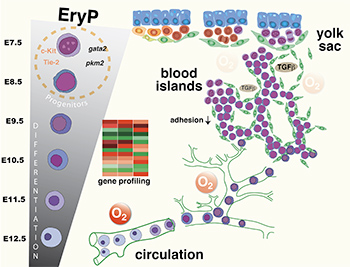Erythropoiesis in health and disease
Erythropoiesis is the process by which progenitors for red blood cells (RBCs) are produced and differentiate. RBCs play an essential role in oxygen delivery and vascular morphogenesis during embryogenesis and throughout postnatal life. We produce more than 1011 RBCs per day from several types of progenitors. The earliest erythroid progenitors are BFU-E (Burst-Forming Unit-Erythroid), which undergo a number of self-renewal divisions before giving rise to more mature progenitors, CFU-E (Colony-Forming Unit-Erythroid). The growth and survival of CFU-E are regulated largely by erythropoietin (EPO) and its receptor. BFU-E respond to a number of hormones and cytokines, including EPO, stem cell factor (SCF), interleukin-3 (IL-3 and IL-6, though how these pathways interact to control BFU-E growth and survival is not understood. Under conditions of stress such as anemia, acute blood loss, or hypoxia, RBC production must increase above the steady-state or basal rate. “Stress erythropoiesis” is driven by EPO, glucocorticoids (GCs) and other factors. In certain clinical settings, the use of EPO is contraindicated. While GCs are well known to stimulate erythropoiesis, they cause severe side effects and their clinical use is limited to situations that are refractory to EPO. The molecular mechanisms underlying the erythropoietic stimulation by GCs are largely unknown.
Anemia is a global health problem that causes significant morbidity and mortality. A mainstay of many medical therapies for anemia is red blood cell (RBC) transfusion but blood supplies are limited. An understanding of how the growth of erythroid progenitors and the switch from self-renewal to differentiation are controlled might facilitate the development of novel erythropoiesis stimulating agents (ESAs) with fewer side effects than EPO (a hormone used to treat many types of anemia) and might lead to improved, more efficient systems for the generation ex vivo of RBCs (or their progenitors) for transfusion.
Overview of mammalian hematopoietic development
For relevant literature, see Baron et al., 2013.
Mammalian hematopoietic development occurs in successive and partially overlapping waves in the embryo and fetus (Fig. 1). In both mouse and humans, the initial wave of hematopoietic activity (primitive) occurs outside the embryo proper, in the yolk sac, and results primarily in the formation of EryP as well as megakaryocytes and macrophages. EryP progenitors can be identified toward the end of gastrulation in the mouse embryo; they arise from bipotential megakaryocyte/erythroid progenitors (MEPs) (Fig. 2). The yolk sac is also the site of a second wave of hematopoiesis that produces definitive erythroid, megakaryocyte, and myeloid cells, and possibly also lymphoid cells. The third wave arises from hematopoietic stem cells (HSCs) that emerge from multiple sites within the embryo, including the para-aortic splanchnopleure (P-Sp), the aorta-gonad-mesonephros (AGM) region and other large arteries (vitelline and umbilical), and the placenta. HSC activity identified following transplantation into newborn (but not adult) mice is also found in the E9.0 yolk sac.
Figure 1. Shifts in site of hematopoiesis during mouse and human development. (A) Hematopoietic development in the mouse. The cartoon depicts formation of mesoderm during gastrulation (around E6.5), development of yolk sac blood islands (~E7.5), emergence of HSCs in AGM region (E10.5; other sites such as large arteries and plancenta not shown), active fetal liver hematopoiesis (E14.5), and hematopoiesis in the bone marrow of the late gestation fetus (E18.5) and adult animal. Active circulation begins ~E9.0. (B) Hematopoietic development in the human embryo. The cartoon shows an embryo at yolk sac stage of hematopoiesis (day 17), at the time of the first hepatic colonization by HSCs (day 23), arterial cluster formation (day 27), second hepatic colonization (day 30), and bone marrow colonization (10.5 weeks). Active circulation begins ~day 21. From Baron et al. (2012) Blood 119: 4828-4837.
Figure 2. Erythroid hierarchy. The HSCs that form in the P-Sp/AGM do not differentiate there but colonize the fetal liver and, later, the bone marrow, thymus, and (in mouse), the spleen.
Primitive erythropoiesis in the yolk sac
Progenitors of the primitive erythroid (EryP) lineage arise early during postimplantation development in the yolk sac of the mammalian embryo. Large, nucleated EryP emerge in great numbers and are the predominant circulating blood cell until a second wave of definitive, enucleated erythrocytes (EryD) is produced by the fetal liver. EryD then rapidly outnumber EryP in the fetal blood. EryP form in the yolk sac, in close temporal and spatial association with endothelial cells. For many years the two lineages were thought to arise from a bipotential progenitor termed the hemangioblast. They have also been described as appearing in “blood islands,” clusters of erythroblasts surrounded by endothelial cells. More recently, the existence of the hemangioblast in vivo and the concept of the yolk sac blood island have both been challenged. EryP progenitor activity, detected using colony-forming assays in vitro, is present from ~E7.5 (embryonic day 7.5) until early somite stages (~E8.75) and disappears rather abruptly, by ~E9.0. Thus, they appear as a nearly synchronous cohort and their progression from proerythroblast to orthochromatic erythroblast to reticulocyte can be readily followed using Giemsa staining (Fig. 3). Morphological hallmarks of their maturation include loss of nucleoli, decreased cell diameter and cross-sectional area, nuclear condensation, changes in expression of cell surface molecules, and, eventually, enucleation. To identify the processes necessary for commitment, expansion, maturation and terminal differentiation of progenitors for this first hematopoietic lineage, a global transcriptional analysis was performed for successive stages of development from E7.5 through E12.5 (Fig. 5). This study revealed that the Wnt pathway functions autonomously in EryP progenitors, the numbers of which are regulated by TGFβ1 and hypoxia. Interestingly, EryP progenitors express genes associated with aerobic glucose metabolism (the Warburg effect), a phenotype characteristic of cancer and other rapidly proliferating cells. Little is known about primitive erythropoiesis in the human yolk sac, owing to the difficulty of obtaining embryonic tissue at this early time in gestation. However, studies using human embryonic stem (ES) cells suggest that human primitive hematopoiesis is broadly similar to that in the mouse embryo.
Figure 3. Cytological changes during EryP maturation. Giemsa-stained cytospin preparations of blood from wild-type embryos. Scale bar, 20 µm. E8.5 GFP(+) cells do not circulate and were FACS-sorted from ε-globin-H2B-GFP transgenic mouse embryos (Isern et al. (2008) Proc. Natl. Acad. Sci. U.S.A. 105, 6662-6667). Circulating blood cells from E9.5-E14.5 were collected by exsanguination. Figure adapted from Fraser et al. (2007) Blood 109: 343-352.
Figure 4. Overlay of bright field and CFP channel fluorescence for an E9.5 ε-globin-H2B-CFP transgenic mouse embryo. Histone H2B-CFP is expressed under the control of a minimal human ε-globin promoter and locus control region, resulting in specific expression in the nuclei of primitive erythroid cells, here observed within the developing vasculature. From Vacaru et al. (2013) Genesis 51(11): 751-762.
Figure 5. Global expression profiles generated at 24 hour intervals from E7.5 through E12.5 revealed two abrupt changes in transcript diversity that coincided with the entry of EryP into the circulation and with their late maturation and enucleation, respectively. These changes were paralleled by expression of critical regulatory factors. Experiments designed to test predictions from these data demonstrated that the Wnt signaling pathway is active in EryP progenitors, whose numbers are regulated by TGF-β1 and hypoxia and which display an aerobic glycolytic profile. This was the first transcriptome assembled for a single hematopoietic lineage of the embryo over the course of its differentiation (Isern et al. (2011) Blood 117: 4924-4934). Fig. by J. Isern.
Mammalian embryonic red blood cells have been designated “primitive” for historical reasons. Like the macrocytic erythroblasts of non-mammalian vertebrate embryos, they form in the yolk sac, enter the circulation as nucleated cells, and their progenitors are produced for only a short time in the embryo. It is now known that EryP continue to mature and do eventually enucleate, several days after entering the bloodstream, where they remain at least through birth. Like EryD, EryP have been found in erythroblastic islands in the fetal liver. EryP enucleation appears to occur in the circulation and in fetal liver, though this process remains to be documented using real-time imaging. The expelled nuclei (also known as “pyrenocytes”) are cleared by macrophages in the fetal liver and perhaps other tissues.
Human primitive erythroblasts enucleate within the placenta. Immunostaining of this tissue suggests that expelled human EryP nuclei are engulfed by macrophages whose developmental origin may also be the placenta.
Biological significance of primitive erythroid cells
Primitive erythroid cells are crucial for the transition from embryo to fetus in developing mammals. In addition to their function in oxygen delivery to cells within the rapidly growing embryo, EryP may scavenge reactive oxygen species and are thought to play a critical role in vascular remodeling during development. The primary capillary plexus of the early yolk sac is remodeled into mature blood vessels that are aligned along the direction of blood flow as cardiac contraction begins. Real-time confocal imaging of ε-globin-GFP transgenic mouse embryos cultured ex vivo revealed that hemodynamic parameters such as shear force change during embryogenesis and that the pattern of blood flow can be correlated with the stage of cardiac development. Erythroblasts are required to generate shear forces necessary for vascular remodeling. In the absence of a heartbeat, as observed for Ncx1 or Mlc2a mutant embryos, shear forces are not generated and the yolk sac vascular plexus fails to remodel. Moreover, in erythroid-tropomodulin (E-Tmod) mutant embryos, the mechanically weakened EryP are unable to support remodeling of the primary capillary plexus into mature vessels. Therefore, circulation between the yolk sac and the embryo proper cannot be established.
Origin of the definitive erythroid lineages in the yolk sac and fetal liver
The fetal liver provides a microenvironment for the robust expansion and differentiation of definitive erythroid cells. The earliest definitive erythroid progenitors that colonize the fetal liver likely originate from erythroid/myeloid progenitors (EMPs) produced during the second wave of hematopoiesis in the (yolk sac E8.25-8.5), rather from HSCs. EMP-derived definitive erythropoiesis has been proposed to bridge the transition between primitive and HSC-derived erythropoiesis.
The third wave of hematopoiesis produces HSCs that seed and differentiate within the fetal liver. By ~E14.5 in the mouse and 7-8 weeks in the human embryo, definitive erythropoiesis is well underway and EryP are rapidly outnumbered by EryD in the circulation. Throughout postnatal life, definitive erythropoiesis originates from HSCs in the bone marrow, under normal physiological conditions. Erythroid cells are also produced in the spleen in response to stress or disease. In both mouse and human EryD, the switch to adult β-like globin gene expression is completed after birth. This switch marks the final event in erythroid ontogeny.
Identification of erythroid cells at different stages of ontogeny and differentiation
Transgenic mouse models for tagging, tracking, and purifying primitive erythroid cells
Primitive and definitive erythroid cells can be partially separated by taking advantage of the difference in their size. However, there are presently no cell surface markers known that uniquely distinguish primitive from definitive erythroid cells. Transgenic mouse lines have been created for tagging and tracking EryP during embryogenesis, using a human β-globin gene promoter and µLCR to target pancellular GFP [63] or nuclear (histone H2B-) GFP to these cells. The bright green fluorescence in β-globin-H2B-GFP transgenic embryos allows the prospective isolation and quantitation of EryP progenitors, which are an abundant cell type at E7.5 (~15% of cells) and E8.5 (40-50%).
Separation of EryD at distinct stages of maturation using flow cytometry
In contrast with the differentiation of primitive erythroid cells as a cohort, definitive erythropoiesis proceeds continuously in the fetal liver and adult bone marrow. Progressive stages of EryD maturation can be separated based on expression of Ter119 and CD71 or CD44. A method for isolating human bone marrow erythroblasts at distinct stages has been reported recently, using other markers whose expression changes more dramatically on human than on mouse red cells.
Two EryD progenitors have been defined functionally using colony assays: the early erythroid burst-forming unit (BFU-E) and later colony-forming unit (CFU-E). Fetal liver BFU-E and CFU-E can be FACS-purified using a combination of negative selection for 9 cell surface proteins and staining for CD71.
Margaret Baron Laboratory
Lab:
Annenberg 24-68
212-241-0838
Admin Phone: 212-241-6287
Fax: 646-537-8698
Email: margaret.baron@mssm.edu
Office:
Annenberg 24-04E
212-241-0825
Icahn School of Medicine at Mount Sinai
1468 Madison Avenue, AB24-68
Box 1079
New York, NY 10029





